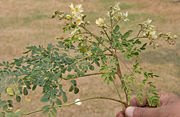 This is the continuation of my internet surfing on the Miracle Plant- Malunggay ( Moringa). The Culinary uses below:
This is the continuation of my internet surfing on the Miracle Plant- Malunggay ( Moringa). The Culinary uses below:
Culinary Uses
The fruit of the tree is quite popular as a vegetable in Asia and Africa. The fruit is a long, thin pod, resembling a drum stick. The fruit itself is called drumstick in India and elsewhere. Moringa leaves are also eaten as a leaf vegetable, particularly in the Philippines and Africa.
India
The moringa pod is known as drumstick or saragwa or saragwe in India. In South India, it is used to prepare a variety of sambar and is also fried. It is also preserved by canning and exported worldwide. In other parts of India, especially West Bengal and also in a neighboring country like Bangladesh it is enjoyed very much. It can be made into varieties of curry by mixing with coconut, poppy seeds and mustard. It can just be boiled, until the drumsticks are semi-soft and consumed directly without any extra processing or cooking. It is used in curries, sambars, kormas, and dals, although it is also used to add flavor to cutlets, etc.
The moringa pod is known as drumstick or saragwa or saragwe in India. In South India, it is used to prepare a variety of sambar and is also fried. It is also preserved by canning and exported worldwide. In other parts of India, especially West Bengal and also in a neighboring country like Bangladesh it is enjoyed very much. It can be made into varieties of curry by mixing with coconut, poppy seeds and mustard. It can just be boiled, until the drumsticks are semi-soft and consumed directly without any extra processing or cooking. It is used in curries, sambars, kormas, and dals, although it is also used to add flavor to cutlets, etc.
Tender drumstick leaves, finely chopped, make an excellent garnish for any vegetable dishes, dals, sambars, salads, etc. One can use the same in place of or with coriander, as these leaves have high medicinal value. If the pulp has to be scraped out after cooking the sticks, then keep the pieces as long as 4-5 inches long. Also do not scrape the skin before boiling. This will help to hold and scrape them more easily and with less mess. For drumstick sambar follow recipe for traditional sambar, adding boiled drumstick fingers, along with onions in the oil, while stir frying.
Scraped drumstick pulp can be made into drumstick bhurtha, more or less like the baingan bhurtha after the pulp has been obtained. It is a wonderfully unusual and tasty dish. The recipe is identical to that of baingan bhurtha.
Scraped drumstick pulp can be made into drumstick bhurtha, more or less like the baingan bhurtha after the pulp has been obtained. It is a wonderfully unusual and tasty dish. The recipe is identical to that of baingan bhurtha.
Drumstick dal, is also a very tasty version of the traditional ‘toor dal‘. Add some of the pulp to the boiled dal, and hand beat it along with the dal before seasoning. This will give an unusual, novel flavor to this dal. In another variation you may add pieces of boiled drumstick including the water in which it was boiled, to the traditional toor dal while it is simmering. The pieces are delightful to chew on with the dal & rice. In addition to being known as Drumstick Dal, the South Indian version which is a spiced lentil soup is more popular by the name – sambar or sambhar. Sambar is usually cooked with toor dal, drumsticks and other locally grown vegetables. The spices used typically in this stew are turmeric, chili powder and cumin among others. It is eaten with rice just like the Drumstick dal.
I think it’s quite interesting and it’s easy to plant and cultivate. Posts are still coming…
http://feeds.feedburner.com/sarahg26/fetz